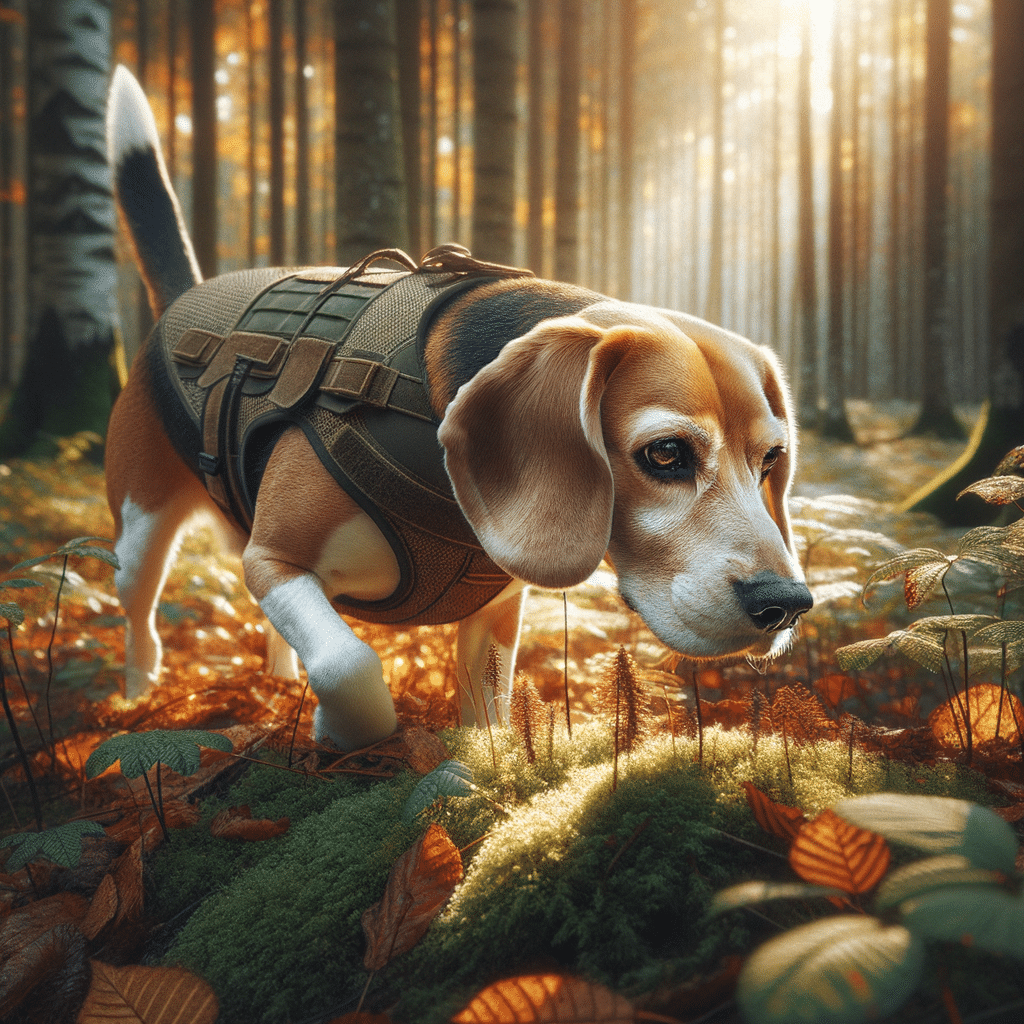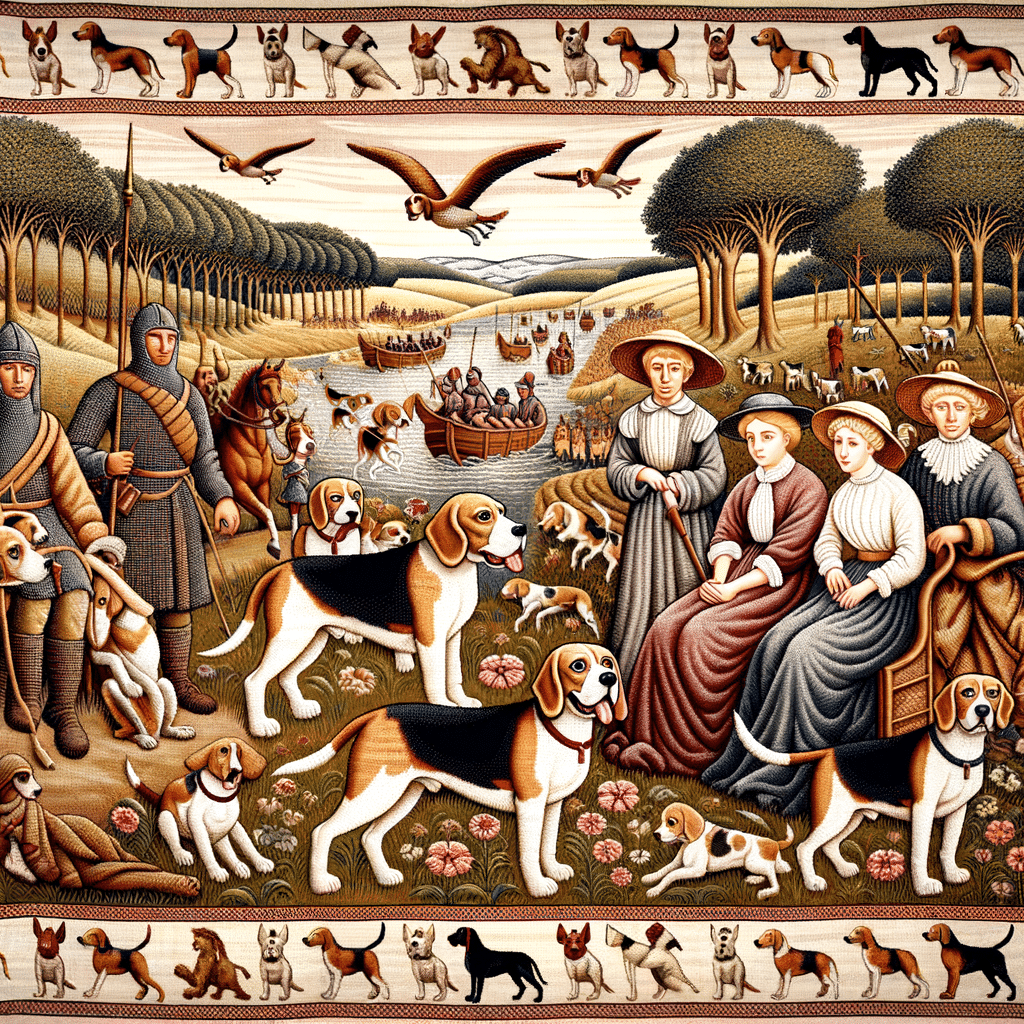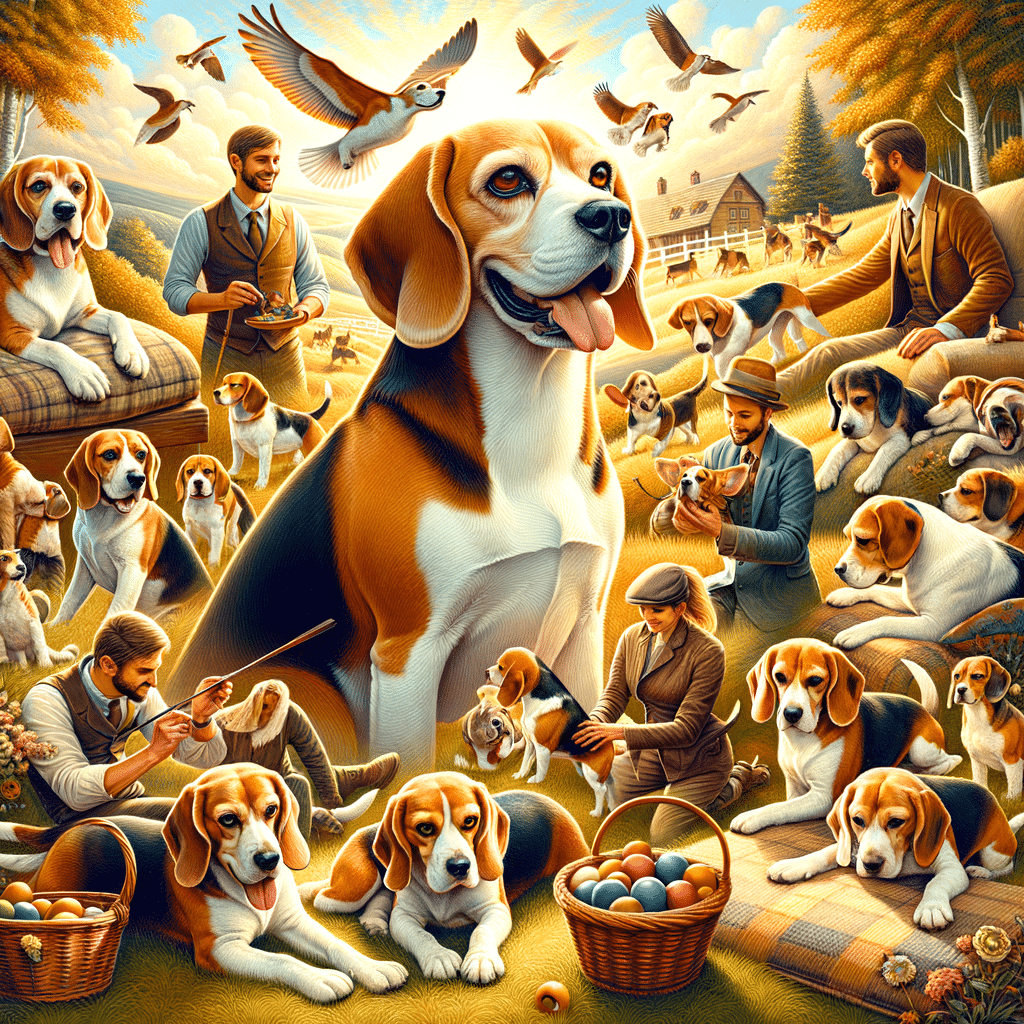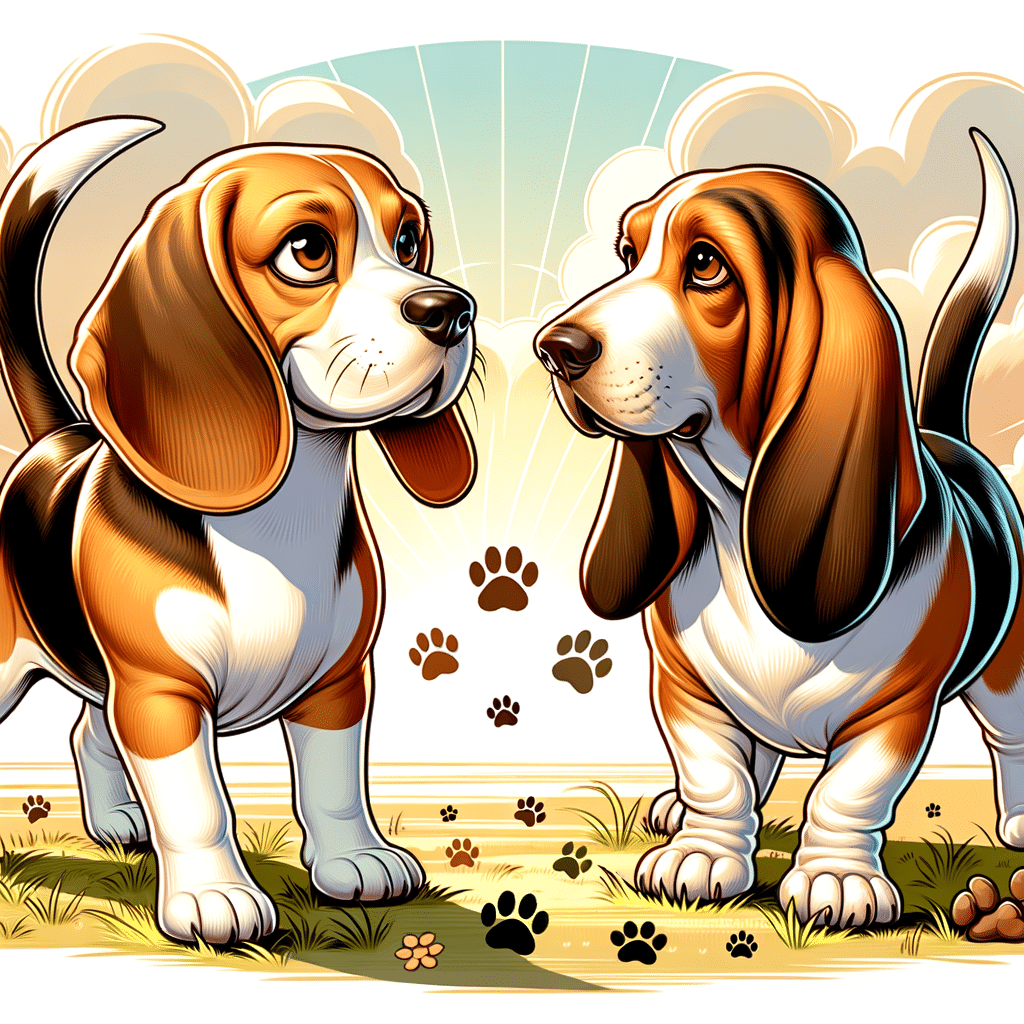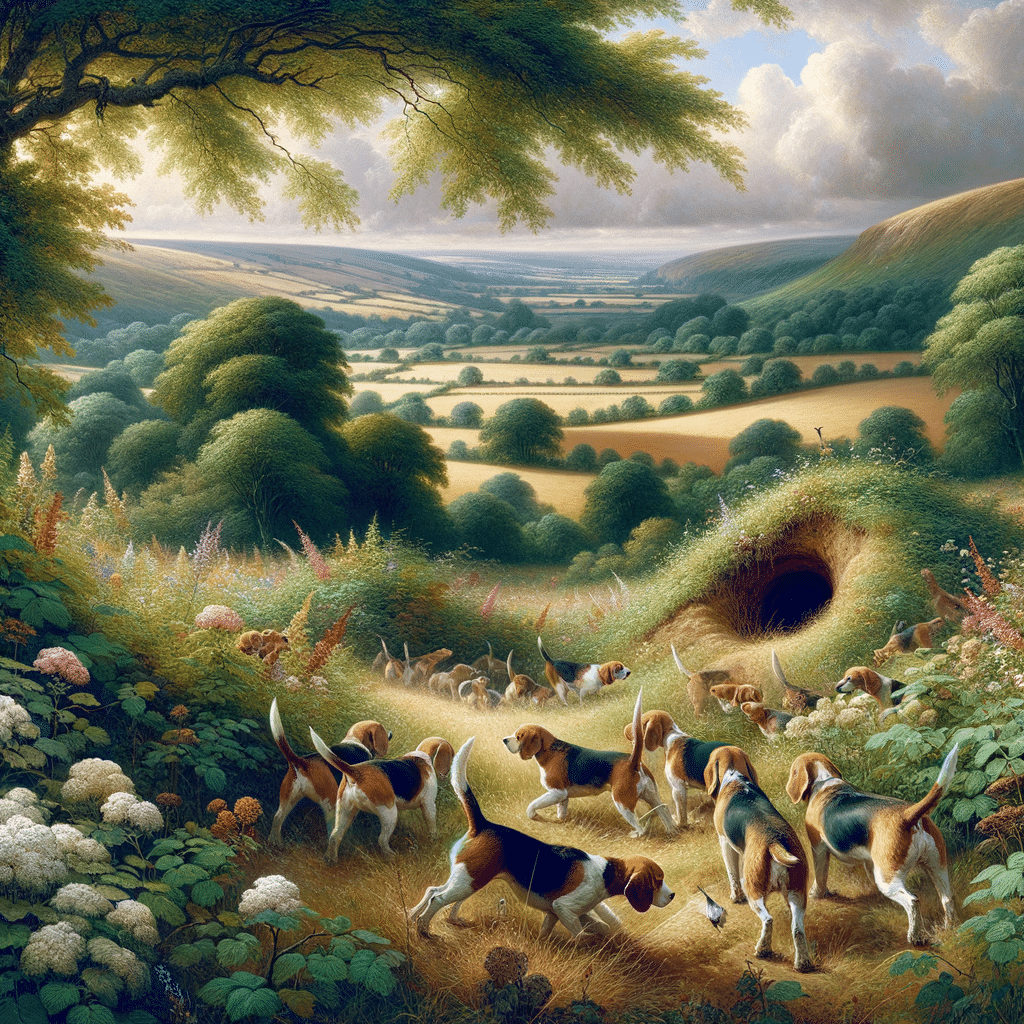Beagles are medium-sized hounds that have become one of the most popular dog breeds due to their size, good temper, and minimal health issues. Originating from Great Britain, this hound dog was developed primarily for hunting hares, known as beagling. The beagle breed is known for its keen sense of smell and instinct for tracking, making this skilled scent hound a staple in the hunter’s arsenal.
In This Article
Over time, different beagles have been bred, but they come in two main size varieties: the smaller one standing below 13 inches at the shoulder and the larger one between 13 and 15 inches.
Major kennel clubs recognize both size categories and share the breed’s friendly demeanor, making them excellent family pets. Beagles are distinguished by their compact, solid bodies and long, floppy ears that lend to their classic hound dog appearance. Despite their hunting heritage, beagles have adapted well to home life, displaying curiosity and companionship.
Proper care for this dog breed includes regular exercise to manage their energetic nature and addressing their potential for certain hereditary health conditions through routine vet check-ups.
Highlights
- The beagle is a popular hound breed, valued for its sense of smell and tracking ability.
- Beagles come in two size varieties, but all share a friendly and energetic temperament.
- Regular exercise and veterinary care are key to maintaining a beagle’s health and happiness.
History and Origin
The beagle’s development in Great Britain resulted from selective breeding practices among various hound breeds. Historical records suggest that the breed might have originated from the Talbot hound in the 11th century and later mixed with other breeds, such as the North Country Beagle and the Southern Hound. The goal was to produce a dog that was small enough to follow on foot but had the stamina and nose to track small game-like rabbits. By the 1500s, the breed had become popular among English hunters for its tracking ability and compact size.
Recognition by Kennel Clubs
By the 19th century, the beagle’s distinct breed characteristics were standardized, leading to its official recognition. The breed was recognized by the American Kennel Club in 1885. Its consistent performance in conformation shows and in the field has cemented its status as both a companion and a sporting dog.
The beagle remains one of the most popular hounds in the United States and remains steadfast in modern dog sports competitions and households.
Breed Varieties and Types
Beagles come in distinct varieties, notably the standard beagle and the smaller pocket beagle. Additionally, a range of beagle mixes has become popular for those seeking unique traits.
Standard Beagle
The standard beagle typically stands between 13 and 15 inches tall at the shoulder, representing the breed standard for a purebred dog. Known for their tri-color coat, this size of beagle is valued for its robust build, keen sense of smell, and friendly temperament‚ characteristics that have made them reliable hunting partners and beloved family pets.
Pocket Beagle
Smaller in stature, the pocket beagle is a smaller version of the standard, usually standing under 13 inches. Despite their small size, pocket beagles are just as cute and friendly, embodying all the favorable qualities of their larger counterparts within a more compact frame.
Beagle Mixes
Beagle mixes combine the charm and hunting prowess of beagles with other breeds, resulting in various unique mixed breed options. Some of these include:
- Puggle: A cross between a beagle and a pug, known for being friendly and affectionate.
- Poogle: A beagle and poodle mix, often prized for their intelligence and lower-shedding coat.
- Cheagle: A mix between a Chihuahua and a beagle, which may inherit the small size and spirited nature of both breeds.
- Beaski: A crossbreed of a beagle and a Siberian husky, typically recognized by their striking eyes and mix of coat colors.
These hybrids often aim to blend the beagle’s scent-tracking ability with other sought-after breed characteristics, such as size, coat type, or temperament.
Temperament and Behavior
Beagles have a playful energy balanced with a dependable loyalty that renders them ideal companions.
Family and Home Interaction
Beagles are known for their social nature, often making them a favored choice for a family pet. The beagle temperament lends to their being good with other dogs and children, displaying both a gentle demeanor and an energetic playfulness that can match the liveliness of kids. As pack animals, they thrive on companionship and prefer not to be left alone for long periods, which can lead to unwanted behaviors such as howling or potential destructiveness.
- Family-friendly: Strongly affectionate and friendly with family members.
- Energetic companions: Their energy and playfulness align well with active households.
Trainability and Intelligence
Beagles are intelligent, which can make them easier to train, but their independent and sometimes stubborn nature occasionally presents challenges. They respond well to training that incorporates play and positive reinforcement. Structured training and socialization from a young age can help mitigate some of the breed’s stubborn tendencies.
- Intelligent: Beagles can learn a variety of commands and tasks.
- Training: Requires consistency; positive reinforcement works best.
Health and Care
The health and well-being of beagles involve proper dog nutrition, awareness of breed-specific health issues, and regular grooming. Addressing these aspects ensures a robust life for these active canines. In addition to the dietary needs and health issues below, one important thing to know about beagles is that they need a lot of physical and mental stimulation to be happy. Prospective owners must understand their needs before adopting a beagle.
Dietary Needs
Beagles require balanced diets that cater to their energetic lifestyles. Owners should provide high-quality dog food that meets nutritional standards specific to the breed. Portion control is critical as beagles are prone to obesity.
Ideal dog food ingredients for beagles:
- Protein (chicken, fish, beef)
- Whole grains
- Vegetables
- Fruits
Common Health Issues
Beagles may experience several health problems throughout their lifetime. Regular veterinary check-ups can aid in early detection and management.
Known health issues in beagles:
- Obesity: Controlled diet and exercise are essential.
- Epilepsy: May lead to seizures, requiring veterinary care.
- Hypothyroidism: Can cause weight gain and lethargy.
- Hip dysplasia: A genetic condition that can affect mobility.
- Allergies: Can manifest in skin irritations or other symptoms.
- Cherry eye: An eye condition that may need surgical correction.
- Ear infections: Due to their long floppy ears trapping bacteria.
Grooming and Shedding
Despite their short fur, beagles need regular grooming to maintain skin and coat health.
- Brush their coat weekly to reduce shedding.
- Regular ear cleaning to prevent infections.
- Nail trims as needed for proper paw health.
Beagles in Society
Beagles have carved out a niche in society, known for their remarkable scent-tracking ability and role as working dogs and loyal companions. They seamlessly transition from the workforce to the heart of the home, embodying the spirit of versatility.
Roles and Responsibilities
Beagles are primarily scent hounds, used for their acute sense of smell and hunting prowess. They excel in rabbit hunting because they can hunt in packs, coordinating with hunters and other dogs. Their tenacity and determination make them superior hunting dogs, and they often participate in tracking and field trial events.
Beyond hunting, beagles serve in various scent-related roles, including contraband detection at airports and assisting in search and rescue operations. Their friendly disposition and non-threatening size also make them ideal for therapy and support work.
Adoption and Rescue
Many beagles end up in animal shelters, awaiting adoption into new homes. Adoption and rescue organizations play a crucial role in rehoming these dogs, often emphasizing the beagle’s adaptability as both family pets and working dogs. These organizations stress the importance of understanding a beagle’s needs for exercise and companionship.
Prospective owners are encouraged to provide a beagle with adequate space to exercise its natural tendencies while embracing its loyal companion role.
Beagle Ownership
Owning a beagle involves understanding their specific needs, including the right living conditions and behavior patterns. Successful beagle ownership requires a blend of providing appropriate space, exercise, and an environment that suits their nature as scent hounds.
Living Conditions
Beagles are adaptable, but their energetic nature requires regular exercise, so a home with a yard is ideal. If you live in an apartment, daily walks and active playtime are essential to meet their exercise needs. Since beagles are notably vocal with a tendency to bark, training is required to manage noise levels, particularly in communal living spaces.
- Exercise requirements: Minimum of one hour per day.
- Secure yard: Preferred for play and exploration.
- Apartment living: Possible with sufficient daily exercise.
Understanding Beagle Behavior
The beagle’s hunting background influences their behaviors and needs. They possess a strong sense of smell and often follow their noses, which can sometimes lead to distraction or wandering. This trait requires owners to be vigilant, particularly when beagles are off-leash. Early socialization is crucial to promote well-adjusted behaviors.
- Watchdog capability: Moderate; will alert owners to new stimuli with barking.
- Barking: They can be loud and frequent without proper training.
- Kid-Friendly: Yes, when socialized from an early age.
Owning a Beagle can be a joyful and rewarding experience by aligning with these requirements and behaviors.
Frequently Asked Questions
Beagles are a popular breed known for their friendly nature and varying sizes. This section addresses common inquiries regarding beagle breeds, temperament, physical characteristics, and factors affecting their pricing.
What are the different sizes of beagle breeds?
The beagle breed comes primarily in two size variations. Standard beagles typically stand 13-15 inches tall, though the UK standard allows for heights up to 16 inches. Pocket beagles, also known as miniatures, are any beagle smaller than 13 inches tall.
How do various beagle breeds differ in temperament?
The beagle temperament is typically friendly and curious. They are known for being affectionate, great with families, and generally social dogs. The pocket beagle might have more energetic bursts due to its smaller size, but the breed maintains a consistent temperament overall.
What is the expected weight range for an adult beagle?
An adult beagle can be expected to weigh between 20 and 30 pounds. The weight may vary based on the specific size of the dog, diet, and level of daily activity.
What are the unique characteristics of a black beagle?
Black beagles are not a separate breed but a color variant within the beagle breed. They often have black markings on their back, ears, and face, typically combined with other colors such as white and brown. Similar to other beagles, they share the breed’s common physical traits and temperament.
